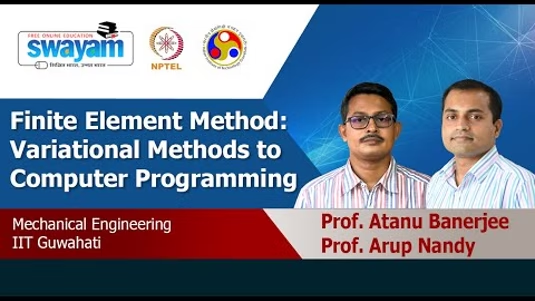Finite Element Method: Variational Methods to Computer Programming free videos and free material uploaded by Indian Institute of Technology, Guwahati (IIT Guwahati). This session contains about Finite Element Method: Variational Methods to Computer Programming Updated syllabus , Lecture notes , videos , MCQ , Privious Question papers and Toppers Training Provided Training of this course. If Material not uploaded check another subject
Week 1:Part1: Variational Methods:Functional and Minimization of Functional; Derivation of Euler Lagrange equation: (a) First variation of Functional, (b) Delta operator Functional with (a) several dependent variables, (b) higher order derivatives; Variational statement Weak Form); Variational statement to Minimization problemRelation between Strong form, Variational statement and Minimization problem;Different approximation methods with Computer Programming: Galerkin, method, Weighted Residual method; Rayleigh Ritz method
Week 2:Part 2. One dimensional Finite Element Analysis:Gauss Quadrature integration rules with Computer Programming; Steps involved in Finite Element Analysis; Discrete system with linear springs;Continuous systems: Finite element equation for a given differential equation Linear Element: Explaining Assembly, Solution, Post- processing with Computer Programming Quadratic element with Computer Programming: Finite element equation, Assembly, Solution, Post-processing; Comparison of Linear and Quadratic element
Week 3:Part 3. Structural Elements in One dimensional FEM:Bar Element with Computer Programming: Variational statement from governing differential equation; Finite element equation, Element matrices, Assembly, Solution, Post-processing; Numerical example of conical bar under self-weight and axial point loads.Truss Element with Computer Programming: Orthogonal matrix, Element matrices, Assembly, Solution, Post-processing; Numerical example
Week 4:Beam Formulation: Variational statement from governing differential equation; Boundary terms; Hermite shape functions for beam element Beam Element with Computer Programming: Finite element equation, Element matrices, Assembly, Solution, Post-processing, Implementing arbitrary distributive load; Numerical example
Week 5:Frame Element with Computer Programming: Orthogonal matrix, Finite element equation; Element matrices, Assembly, Solution, Post- processing; Numerical examplePart 4. Generalized 1D Finite Element code in Computer Programming:Step by step generalization for any no. of elements, nodes, any order Gaussian quadrature;Generalization of Assembly using connectivity data; Generalization of loading and imposition of boundary condition; Generalization of Post-processing using connectivity data;
Week 6:Part 5. Brief background of Tensor calculus:Indicial Notation: Summation convention, Kronecker delta and permutation symbol, epsilon-delta identity; Gradient, Divergence, Curl, Laplacian; Gauss-divergence theorem: different forms
Week 7 & 8 :Part 6. Two dimensional Scalar field problems:2D Steady State Heat Conduction Problem, obtaining weakform, introduction to triangular and quadrilateral elements, deriving element stiffness matrix and force vector, incorporating different boundary conditions, numerical example.Computer implementation: obtaining connectivity and coordinate matrix, implementing numerical integration, obtaining global stiffness matrix and global force vector, incorporating boundary conditions and finally post-processing.
Week 8 & 9:Part 7. Two dimensional Vector field problems:2D elasticity problem, obtaining weak form, introduction to triangular and quadrilateral elements, deriving element stiffness matrix and force vector, incorporating different boundary conditions, numerical example.Iso-parametric, sub-parametric and super-parametric elements Computer implementation: a vivid layout of a generic code will be discussed Convergence, Adaptive meshing, Hanging nodes, Post- processing, Extension to three dimensional problems Axisymmetric Problems: Formulation and numerical examples
Week 10:Part 8. Eigen value problemsAxial vibration of rod (1D), formulation and implementation Transverse vibration of beams (2D), formulation and implementation
Week 11:Part 9. Transient problem in 1D & 2D Scalar Valued ProblemsTransient heat transfer problems, discretization in time : method of lines and Rothe method, Formulation and Computer implementationsWeek 12: Choice of solvers: Direct and iterative solvers
Finite Element Method (FEM) is one of the most popular numerical method to boundary and initial value problems. One distinct feature of FEM is that it can be generalized to the domains of any arbitrary geometry. Theory of FEM is developed on Variational methods. In this course, finite element formulations will be derived from the governing partial differential equation of different physical systems based on Variational methods. It will start with one-dimensional Bar, Beam, Truss, Frame elements; and will be extended to two-dimensional structural, and thermal problems. The framework of standard master element in both 1D and 2D will be followed, so that transformation for any arbitrary geometry is well understood. Two dimensional formulation will be represented in Tensorial framework, after building necessary background in Tensor calculus. Most importantly for every element, the basic code for computer implementation will be provided and explained with step-by-step clarification. We will also elaborately present how to prepare a generalized FEM code with first hand implementation.
INTENDED AUDIENCE :Final year Under Graduate Students, First year Post Graduate Students
PREREQUISITES : Solid Mechanics, Engineering Mathematics: Linear Algebra, Vector Calculus
INDUSTRIES SUPPORT :DRDO, ISRO, BARC, GE, Automobile and Aviation industries

- 0 Reviews
- 1 Students
- 174 Courses

Write a public review